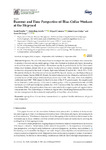Mostrar o rexistro simple do ítem
Burnout and Time Perspective of Blue-Collar Workers at the Shipyard
| dc.contributor.author | Detaille, Sarah | |
| dc.contributor.author | Reig-Botella, Adela | |
| dc.contributor.author | Clemente, Miguel | |
| dc.contributor.author | López-Golpe, Jaime | |
| dc.contributor.author | De Lange, Annet | |
| dc.date.accessioned | 2020-10-22T13:16:01Z | |
| dc.date.available | 2020-10-22T13:16:01Z | |
| dc.date.issued | 2020 | |
| dc.identifier.citation | Detaille, S.; Reig-Botella, A.; Clemente, M.; López-Golpe, J.; De Lange, A. Burnout and Time Perspective of Blue-Collar Workers at the Shipyard. Int. J. Environ. Res. Public Health 2020, 17, 6905. | es_ES |
| dc.identifier.issn | 1660-4601 | |
| dc.identifier.uri | http://hdl.handle.net/2183/26504 | |
| dc.description.abstract | [Abstract] Background: The aim of the research was to investigate the association between time perspective in relation to burnout and successful ageing of blue-collar workers with physically highly demanding work and low autonomy. Shipyard blue-collar workers usually do predominantly manual labor versus white-collar workers, whose jobs do not usually involve physical work. Methods: 497 participants workers in a shipyard in the north of Spain. Ages were between 20 and 69 (M = 46.62, SD = 10.79). We used the Zimbardo Time Perspective Instrument (ZTPI), Spanish version, and the Maslach Burnout Inventory–General Survey (MBI-GS). Results: Emotional exhaustion factor obtained a coefficient of 0.97; cynicism factor of 0.83; and professional efficacy factor of p = 0.86. The mean of the three reliability coefficients was 0.887. With respect to the five factors of the ZTPI questionnaire: the negative past factor obtained a coefficient of p = 0.91; that of positive past p = 0.81; the present hedonistic of 0.878; the future of p = 0.83; and the fatalistic present of p = 0.90. The mean of the five coefficients, was p = 0.86. Conclusions: Within shipyard workers, burnout is associated with a negative past and negative future time perspective. This makes shipyard workers at a higher risk of developing burnout and this can have serious consequences for the sustainable employability of these blue-collar workers. | es_ES |
| dc.language.iso | eng | es_ES |
| dc.publisher | MDPI | |
| dc.relation.uri | https://doi.org/10.3390/ijerph17186905 | |
| dc.rights | Atribución 4.0 | |
| dc.rights.uri | http://creativecommons.org/licenses/by/4.0/ | |
| dc.subject | Blue-collar workers | es_ES |
| dc.subject | Ageing | es_ES |
| dc.subject | Cross-sectional | es_ES |
| dc.subject | Occupational health | es_ES |
| dc.subject | Risk burnout | es_ES |
| dc.subject | Shipyard | es_ES |
| dc.title | Burnout and Time Perspective of Blue-Collar Workers at the Shipyard | es_ES |
| dc.type | journal article | es_ES |
| dc.rights.accessRights | open access | es_ES |
| UDC.journalTitle | International Journal of Environmental Research and Public Health | es_ES |
| UDC.volume | 17 | es_ES |
| UDC.issue | 18 | es_ES |
| UDC.startPage | 1 | es_ES |
| UDC.endPage | 10 | es_ES |
| dc.identifier.doi | 10.3390/ijerph17186905 | |
| UDC.coleccion | Investigación | es_ES |
| UDC.departamento | Dereito Público | es_ES |
| UDC.grupoInv | Criminoloxía, Psicoloxía Xurídica e Xustiza Penal no Século XXI (ECRIM) | es_ES |
Ficheiros no ítem
Este ítem aparece na(s) seguinte(s) colección(s)
-
Investigación (FDER) [677]






